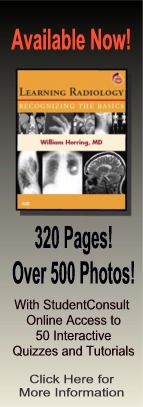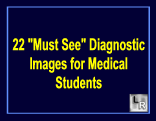| Cardiac | |
|---|---|
| GI | |
| Bone | |
| GU | |
| Neuro | |
| Peds | |
| Faculty | |
| Student | |
| Quizzes | |
| Image DDX | |
| Mobile | |
| |
Misc |
| Videocasts | |
LearningRadiology Imaging Signs
on Twitter
![]()
Follow us on
What sign is depicted on this image?
- 51 year-old with wrist pain

Frontal radiograph of the wrist
1. Pronator quadratus sign
2. Triangular lunate sign
3. Ring sign
4. Carpal fusion sign
5. Target sign
Additional Images - None
![]()
Additional Images
.
None
![]()
Answer:
.
3. Ring Sign
.
.
More (Click Discussion Tab)
Scaphoid Cortical Ring Sign
General Considerations
- The scaphoid cortical ring sign is produced by the foreshortened appearance of the distal pole of the scaphoid rotated on its axis by scapholunate dissociation, one of the manifestations of carpal instability syndromes
- It may, however, be present normally and should be evaluated in light of clinical findings
- Normally, the distance between the scaphoid and the lunate is < 3 mm in the frontal view
.
This Week
51 year-old with wrist pain |
This podcast reviews the thoracic imaging manifestations of sarcoid, its diagnosis, staging and prognosis. There is a mini-quiz at the end. |
Review descriptions of key imaging signs in the shorthand of Tweets by subscribing to this new LearningRadiology Twitter feed for your computer or cell phone
|
Some of the fundamentals of interpreting chest images |
The top diagnostic imaging diagnoses that all medical students should recognize according to the Alliance of Medical Student Educators in Radiology |
Recognizing normal and key abnormal intestinal gas patterns, free air and abdominal calcifications |
Recognizing the parameters that define a good chest x-ray; avoiding common pitfalls |
How to recognize the most common arthritides |
| LearningRadiology.com |
is an award-winning educational website aimed primarily at medical students and radiology residents-in-training, containing lectures, handouts, images, Cases of the Week, archives of cases, quizzes, flashcards of differential diagnoses and “most commons” lists, primarily in the areas of chest, GI, GU cardiac, bone and neuroradiology. |


